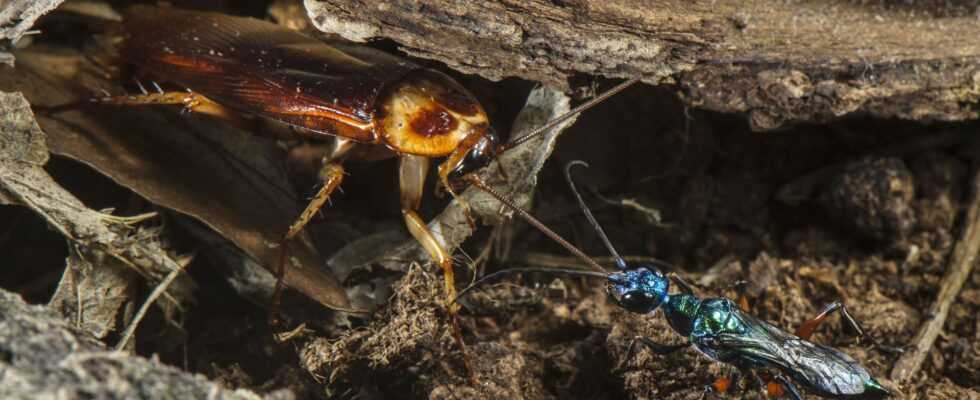To test this, I drugged some animals and trimmed their hair. This was a rather delicate procedure, which I could only perform by holding the befuddled wasp with two fingers while simultaneously shaving its rear end with an ultra-sharp obsidian scalpel. The adventurous-sounding method finally worked, and the results confirmed my suspicions: depilated wasps had trouble laying their eggs in the right place. My observations not only revealed an important tactile mechanism for laying the egg, but also confirmed that its exact positioning is of central importance. A larva hatched in the wrong place usually died before finding the roach’s sore spot.
Each wasp stings not just two, but three times before laying its eggs
While studying the wasp’s sensory hairs and the survival of its larvae, I made another completely unexpected discovery. Before a female wasp found the ideal spot for her egg, she repeatedly probed a spot on the cockroach’s ventral side just in front of the middle pair of legs with the outstretched tip of her abdomen. In response, the cockroach would often stretch out its middle leg on the wasp’s side — as if bothered by the poking at its underside.
At first I couldn’t make sense of the behavior. It seemed like a sideshow, distracting the wasp from laying her eggs and distracting me from my investigations. Out of curiosity, I finally decided to take a closer look at the groping under a higher magnification. To my amazement, I found that the wasp wasn’t just poking around aimlessly. Instead, I saw the extended spine slide beneath the partially transparent cuticle. But how could that be? Anyone who studies the jewel wasp knows that it stings the roach twice—once in the prothoracic ganglion to paralyze the front legs, and once in the brain to turn the cockroach into a zombie. Maybe I was looking at a confused outsider who was acting unusually.
© Matthew Twombly / Scientific American February 2021; German editing: spectrum of science (excerpt)
© Matthew Twombly / Scientific American February 2021; German editing: spectrum of science (excerpt)
© Matthew Twombly / Scientific American February 2021; German editing: spectrum of science (excerpt)
© Matthew Twombly / Scientific American February 2021; German editing: spectrum of science (excerpt)
I decided to shift my focus – both literally and figuratively – and get to the bottom of the observation. I soon found out that each female jewel wasp stings the roach’s midbody three times before laying her eggs, beneath a specific section of her carapace called the basal ternum. The structure lies just above the mesothoracic ganglion, another element of the central nervous system. The very first wasp sting, which paralyzes the cockroach’s front legs at the beginning of the attack, targets the prothoracic ganglion. The mesothoracic ganglion contains motor neurons that control the roach’s middle two legs, one of which the wasp will choose to lay its egg. I also noticed that the odd leg extension happened just a few seconds after the extra stitches. Apparently these caused the cockroach to move its leg. Could the process possibly be another aspect of controlling the cockroach?
It was a possibility, but how could I tell if the wasp actually entered the mesothoracic ganglion, which lies deep inside the cockroach? A similar question had already been asked in connection with the first stab in the prothoracic ganglion and had been discussed controversially for a long time until Libersat and his then institute colleague Gal Haspel finally solved the mystery in 2003 with an ingenious experimental approach. They marked the wasp radioactively – and thus its poison. After the sting, the two researchers were able to detect the radiating substances in the prothoracic ganglion of the cockroach.
I had neither the courage to experiment with radioactive wasps nor the interest in doing all the paperwork that would have involved getting the permit to do so. Luckily, I found a more direct way to get a glimpse of the venom injection site. I anesthetized a cockroach and cut a small window in its cuticle so that the ganglion could be seen. Then I increased the magnification on my microscope and watched the wasp attack. Incidentally, such an approach would not have worked when tracing the first wasp sting, since this takes place during the bitter duel between cockroach and wasp. But now it was clearly recognizable: The stitch was aimed at the mesothoracic ganglion. He also aimed at the side of the ganglion that controls the leg to which the wasp sticks its egg. Apparently, the venom injected with these later bites contains a component that activates motor neurons, causing stretching.
